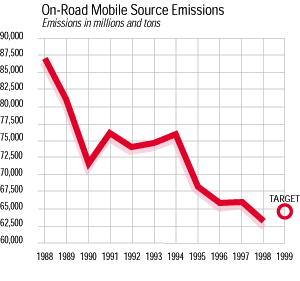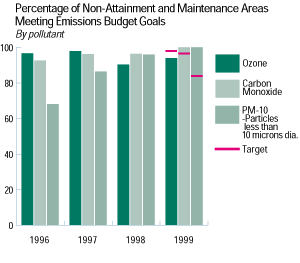| Connecting America - 1999 Report to the Nation | 11 of 16 |
Human and Natural EnvironmentProtect and enhance the natural environment and communities affected by highway transportation.Transportation has major effects on our quality of life--where we choose to live and how we get to jobs, services, shopping, and recreation. FHWA enhances the community and social benefits of transportation by supporting welfare-to-work, mobility for people with low incomes, and accessibility for people with disabilities. FHWA also helps reduce the adverse effects of transportation on the natural environment by supporting efforts such as wetland mitigation, and water and air quality improvements. Community and Social Benefits Enhancement FHWA works to address community concerns about the social impacts of its transportation plans. We strive to reduce the adverse effects of siting, constructing, and operating transportation facilities. FHWA works closely with resource agencies, such as the Environmental Protection Agency (EPA) and the U.S. Army Corps of Engineers, to identify and ease the unavoidable impacts on the natural environment associated with highway projects. Such cooperation in the early stages minimizes disruption and speeds project completion. In 1999, an innovative FHWA grants program, called "Transportation and Community and System Preservation Pilot Program" (TCSP), awarded $13.1 million to 35 projects in 27 states and the District of Columbia. Under TCSP, states, local governments, and metropolitan planning organizations can plan and carry out strategies that improve the efficiency and environmental- friendliness of the transportation system. On-Road Mobile Source Emissions Measures for Success: (1) Reduce the on-road mobile source emissions. (2) Increase the percentage of nonattainment and maintenance areas meeting their mobile source emissions budget.
 Pollution. Whether visible as smoke and soot, or so small that you need a microscope to see it, impure air threatens our health and reduces our quality of life. Pollution damages vegetation and, at times, surrounds some communities with a dense haze. Transportation accounts for 25 percent to as much as 77 percent of the different air-polluting emissions in this country. Emissions from cars, trucks, and buses contribute one-third to three-quarters of total mobile source emissions. There are many ways Americans can reduce these hazardous emissions, such as limiting trips, sharing rides, or using mass transit. FHWA seeks to promote these efforts and innovative approaches such as public information initiatives to reduce congestion and air pollution emissions.
 Currently, at least $1.35 billion a year is spent for these projects--a 35 percent increase over previous funding levels. Our efforts, and those of all Americans, appear to be paying off. The total tonnage of mobile-source emissions continues to decline, as much as 60 percent since 1970; and areas with serious problems are more successful in meeting their pollution reduction goals. Wetland Protection and Recovery Measure for Success: Replace at least an average of 1.5 acres of wetlands for every 1 acre directly affected by federal-aid highway projects where impacts are unavoidable.
Wetlands are an important asset to our nation. They reduce flood damage, improve water quality, and support life in its myriad forms. The Clinton Administration's Clean Water Action Plan (CWAP) requires government agencies to reverse the historic pattern of wetland losses in the United States and achieve a net increase of 100,000 acres of wetlands each year, beginning in 2005. Under the plan, FHWA has committed to increase net wetland acreage resulting from federal-aid highway projects by 50 percent in 10 years. In 1999, 5,409 acres of wetlands were replaced to compensate for 2,354 acres of wetlands that were unavoidably impacted by federal highway projects. This equates to a 2.3:1 replacement ratio or an increase in wetlands of 130 percent, far exceeding our goal. Accomplishments
Environmental Streamlining: Just Common Sense
The millions of Americans who use highway and transit systems every day stand
to benefit from a new streamlined process, formalized by those federal agencies
that have primary responsibility for protecting the environment. The concept
has already helped an economically depressed area of northeastern Kentucky,
where 34 different organizations worked together to plan and design a badly
needed industrial parkway. The environmental review process was completed in
record time, with no duplication of effort or compromising of environmental
safeguards.
Making It Crystal Clear in Tahoe
Lake Tahoe is one of the clearest large lakes in the world. To keep it that
way, the Nevada DOT launched a multifaceted program to prevent the lake's
water quality from declining by controlling the sources of erosion and by treating
the runoff from nearby roadways. The Lake Tahoe Water Quality Demonstration
Project won a 1999 FHWA Environmental Excellence Award.
Hitting the Airwaves to Clear the Air
This advertisement is part of a multiyear, coalition-based "Public Information Initiative on Transportation and Air Quality" jointly funded by EPA and FHWA. This initiative is in response to state and local governments that asked us to help them meet federal air quality goals. Although cars are 97 percent cleaner than they were in 1970, states and communities still face tough challenges meeting more stringent air quality standards. In 1999, the initiative generated half-a-million dollars' worth of advertising, and pre- and post-project surveys showed a marked increase in driver awareness. The campaign has now expanded from 3 to 75 communities. Planning for GrowthA public-private partnership called "Envision Utah" has begun to reverse the effects of too-rapid growth in an area stretching 100 miles north and south of Salt Lake City. Close to 80 percent of Utah's residents live in this narrow corridor. "Envision Utah" used TCSP funds to develop a publicly supported "Quality Growth Strategy" to help keep Utah beautiful, prosperous, and neighborly for future generations. When the strategy's goals are met, there will be more land conservation, more housing choices, less air pollution, reduced water consumption, and less traffic congestion. The models predict that the Quality Growth Strategy will save taxpayers more than $4.5 million over the next 20 years. Creating a More Livable BoulderThanks to the HOP and the SKIP Community Transit System, residents of Boulder, Colorado, can get around town easier and faster--and in cleaner air. The HOP shuttles circulate through Boulder's main activity centers and run every 10 to 15 minutes, with late-night service for University of Colorado students. The SKIP links the northern and southern residential areas to the downtown area university, and it runs every 6 minutes during rush hour. Each HOP and SKIP bus holds 38 passengers and is equipped with bike racks and a wheelchair lift. More than 1.5 million riders used the SKIP in 1999, cutting vehicle-miles traveled by 3.1 million. The SKIP's alternative-fuel engines and electrically controlled diesel engines also reduced emissions by at least 80 percent. Boulder's easy-access, high-frequency shuttle services, partially funded by the Congestion Mitigation and Air Quality Program, received a 1999 FHWA Environmental Excellence Award.
| |||||||||||||||||||||
|
Related Links:
|